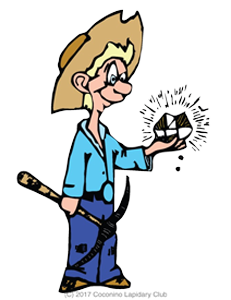Along with the colors and crystal forms of minerals, their mechanical properties such as the hardness. tenacity, and habits of structural failure can be very useful tools in identifying an unknown mineral. In this first Blog on the use of mechanical properties in identifying minerals I’ll focus on hardness and describe the Moh’s Hardness Scale, the standard reference scale for minerals, and briefly describe how to use it. I’ll also list those often available objects which can be usedinstead of a mineral member of the scale as hardness references for comparison with the mineral.
The Mohs Hardness Test and Scale were invented in 1812 by the German mineralogist Fredrich Moh[Ref1,2] as a means to rank minerals according to their relative hardness in resisting scratching. Its ease of use has resulted in its wide application by mineral collectors and lapidarists. The ten-point scale begins with the softest mineral talc assigned a hardness of 1 and ends with the hardest mineral diamond assigned a hardness of 10. Minerals with intervening hardness values between 2 and 9 are: gypsum (selenite) at a hardness of 2, calcite at 3, fluorite at 4, apatite at 5, orthoclase (feldspar) at 6, quartz at 7, topaz at 8, and corundum (ruby, sapphire) at 9. In Figure 1 shows the hardness scale, and as well, includes everyday objects of known hardness which can also be used in hardness testing[Ref2]. The relative hardness values are obtained by determining which mineral scratches one of lesser hardness and is scratched by a mineral or an object of greater hardness. Testing is done by placing a sharp point of one mineral or another testing agent against the surface of another and attempting to scratch it. One of the following results may be observed:
If mineral A scratches mineral B then A is harder than B.
If A doesn’t scratch B then B is harder than A.
If A and B are relatively ineffective in scratching each other they are of equal hardness.
If A can be scratched by B but not by C the hardness o A is between the hardness of B and C.
The Mohs Hardness Test is performed using the steps and tips as described in
Figures 2 and as shown live in the YouTube video accompanying this brief presentation. An example of testing using a knife and a penny are described in Figure3.



REFERENCES
Ref 1. https://en.wikipedia.org/wiki/Friedrich_Mohs
Ref2. https://geology.com/minerals/mohs-hardness-scale.shtml
Ref 3. https://www.lindahall.org/friedrich-mohs/
Ref 4. https://www.nbc12.com/story/17003531/jens-coin-story/
